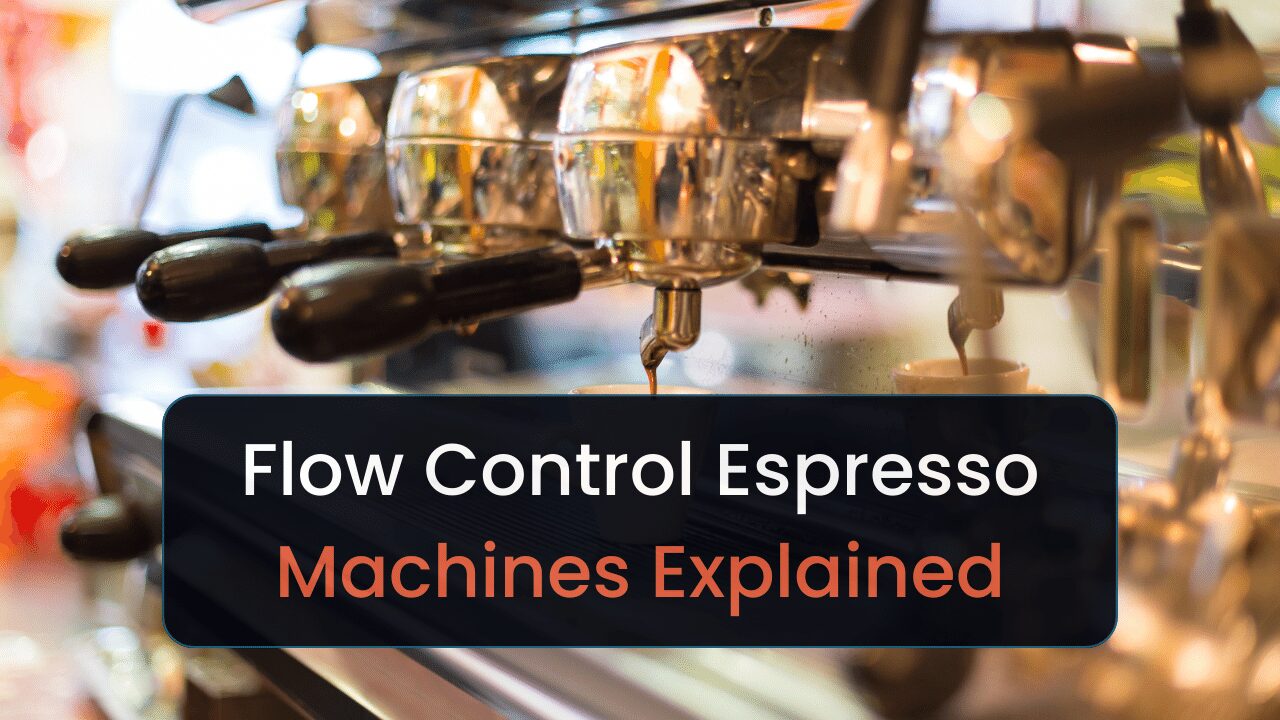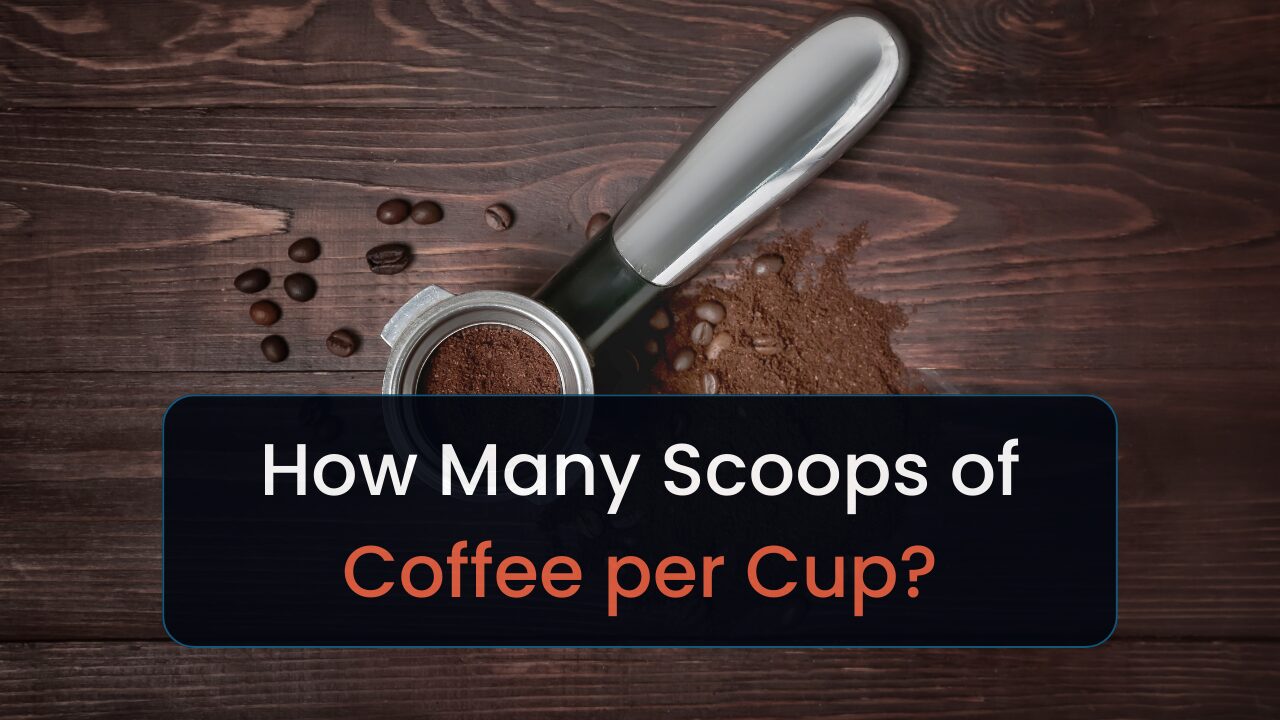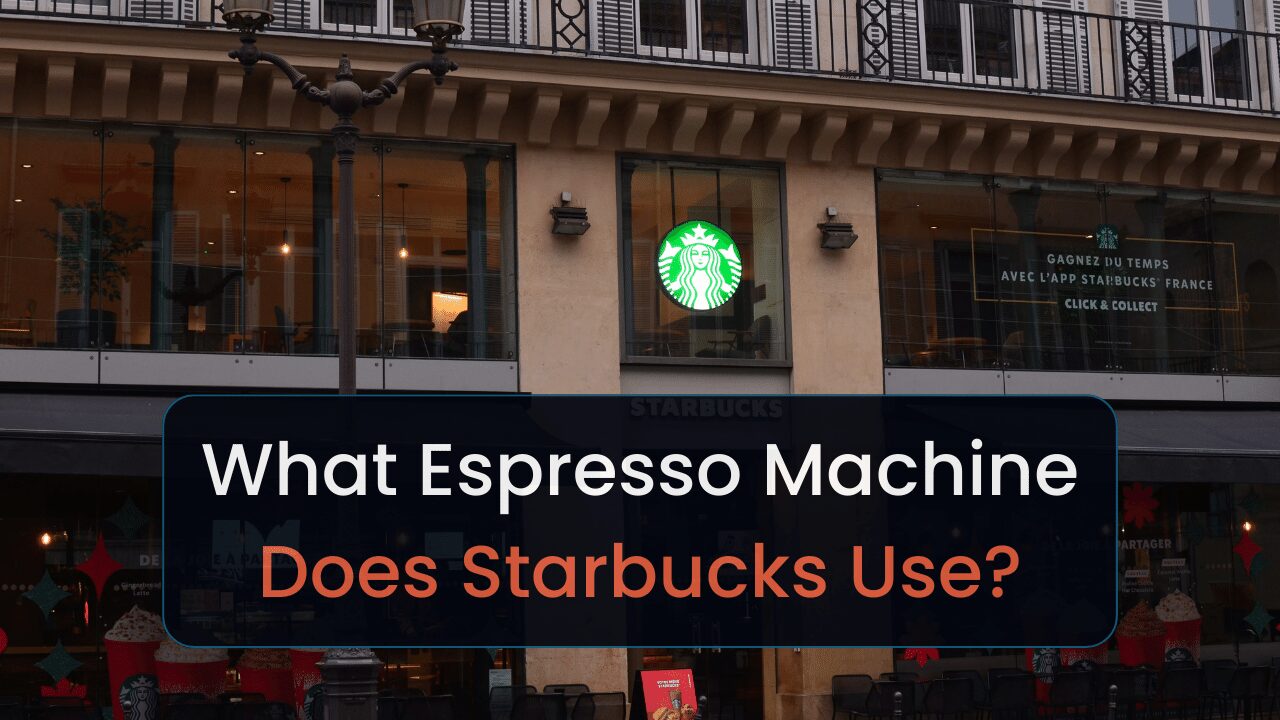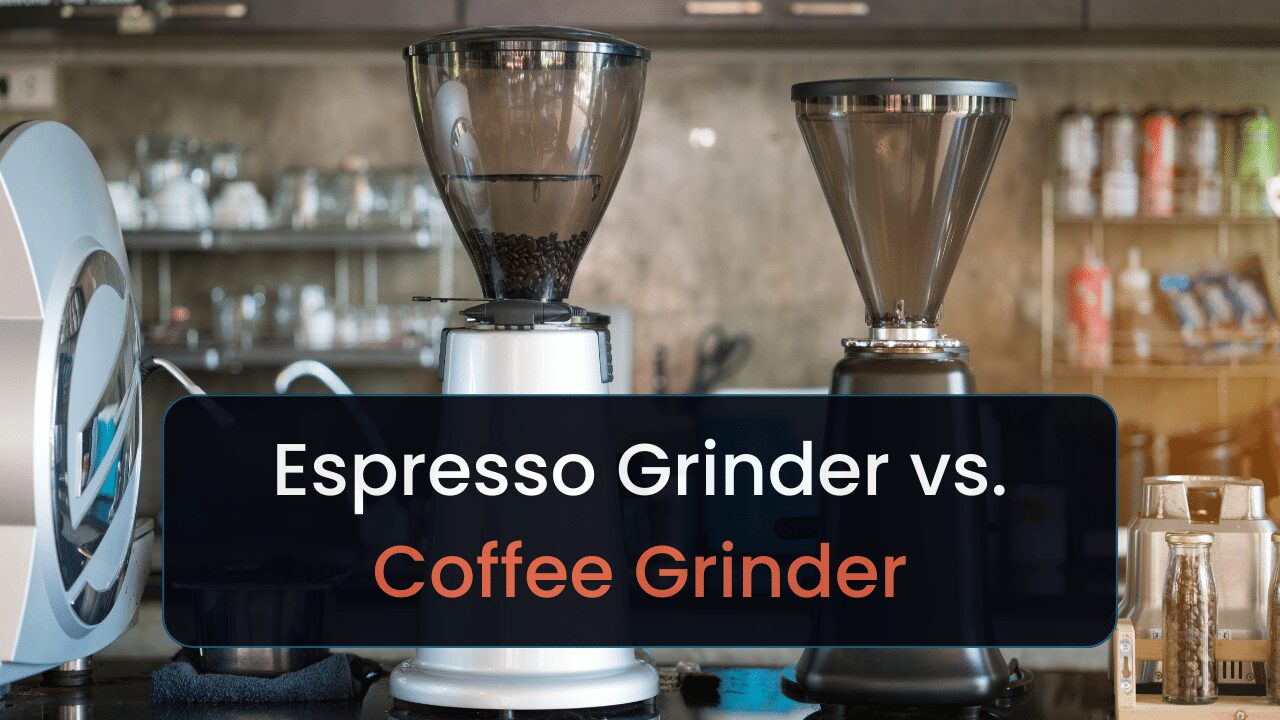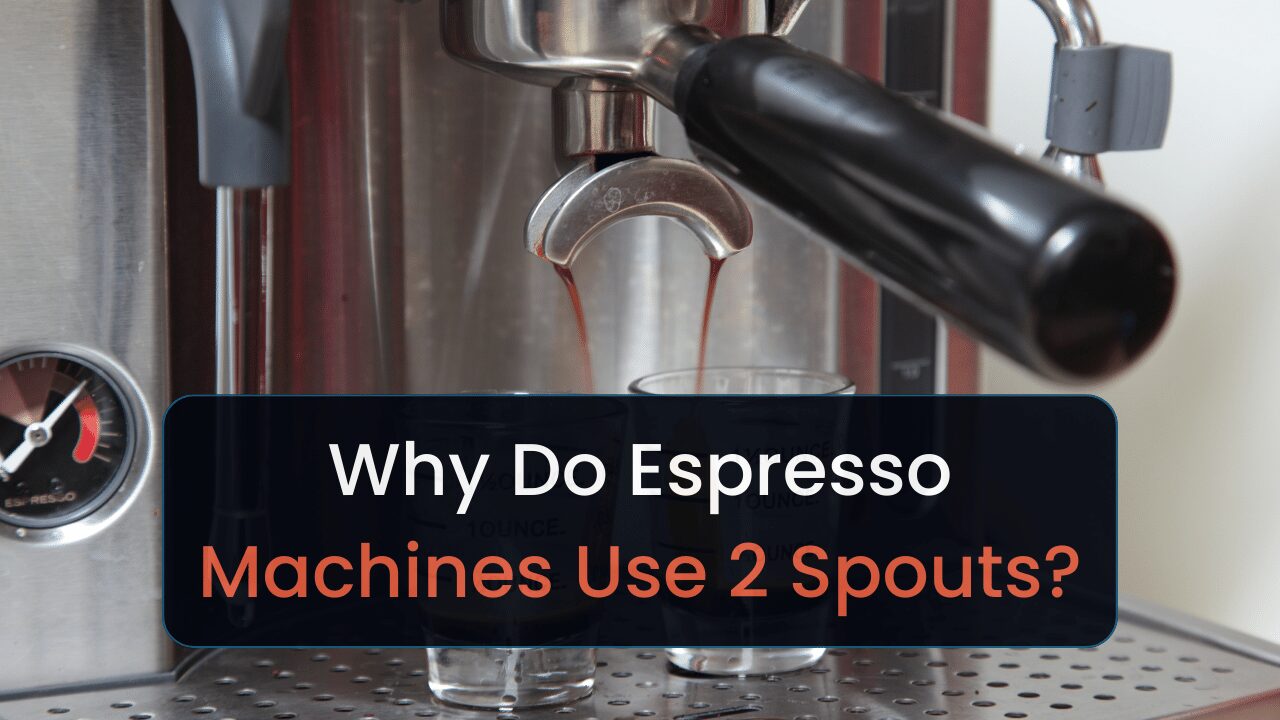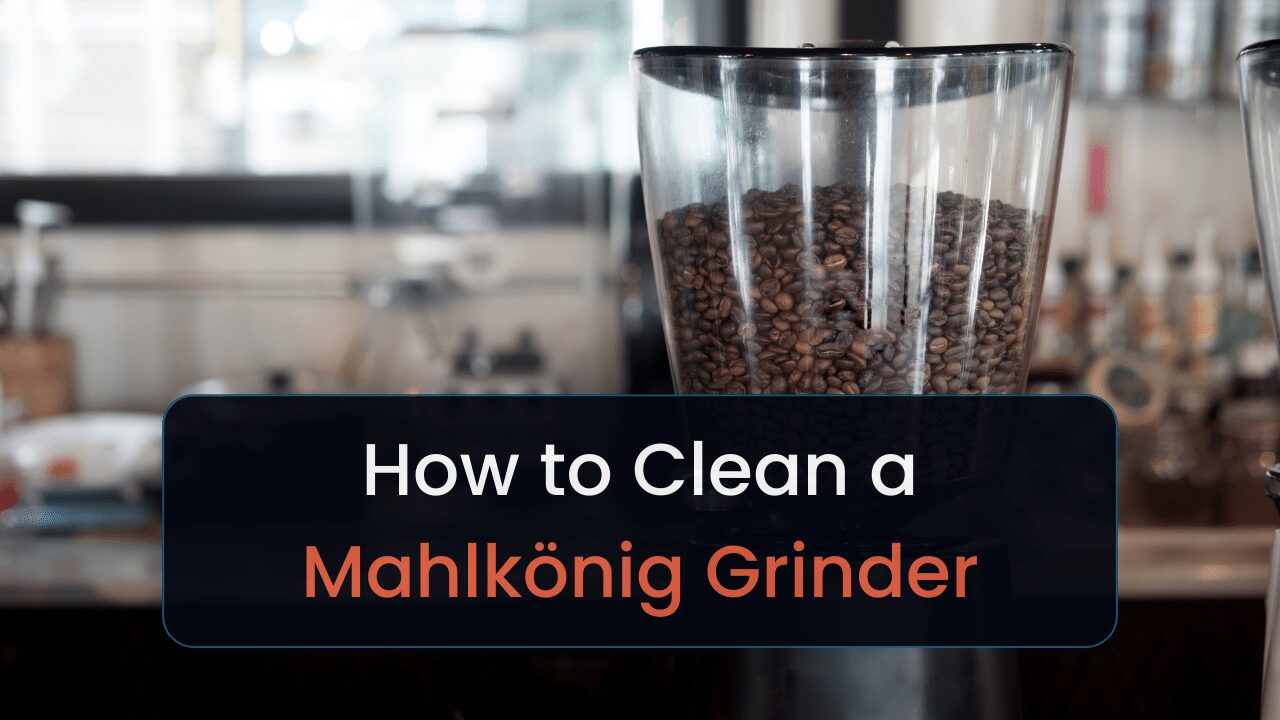This guide is an overview of the best coffee makers with a programmable timer. Keep reading to learn more.
I sometimes hate having to wait for coffee in the morning. I want the coffee machine to do everything for me before waking up. That led me to search for a programmable coffee maker. This guide has my findings.
I chose the Breville Precision Brewer as the best coffee maker with a timer because it allows you to choose between using presets and controlling various attributes of your machine’s brewing.
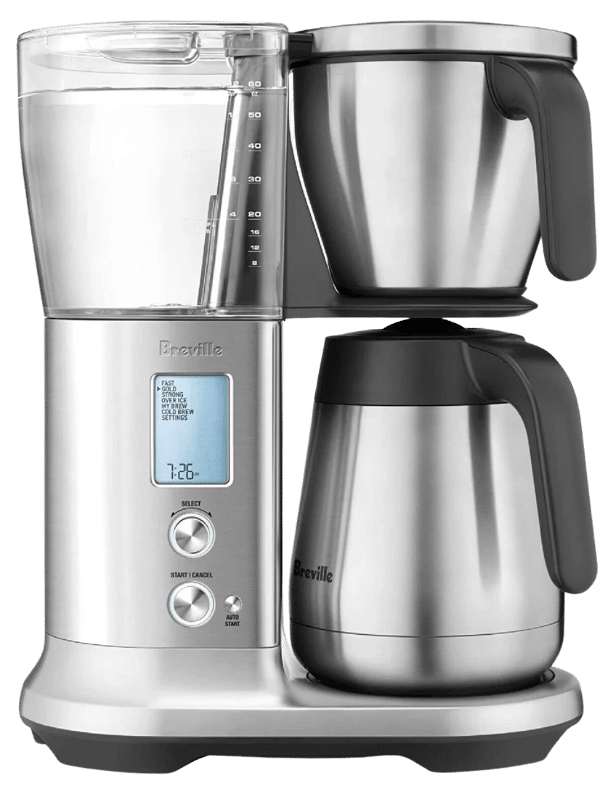
Breville Precision Brewer:
Best Overall
- Price: $$$
- Carafe Type: Thermal
- Water Tank Size: 10 cups
- Dimensions (D × W × H): 7.5 × 12 × 15.75 in
- Warranty: 1 year
Such a feature makes this machine excellent for casual and enthusiast coffee drinkers. It’s a bit costly, though. I’ll provide more affordable alternatives.
Let’s dive in.
Best Coffee Makers With a Timer for Home Use
- Breville Precision Brewer: Top pick
- Zojirushi EC-ESC120: Runner-up but affordable
- Cuisinart DGB-800: Includes timer and grinder
- Capresso 5-Cup Mini Drip Coffee Maker: Most compact and cheapest
- Keurig K-Elite: Best single-serve machine
- Ninja CFP301: Best for iced coffee
- Technivorm Moccamaster + Timer Plug: Best machine in the UK
Best Coffee Makers With a Timer
The following sections will compare these factors:
- Specifications
- Pros and cons
- Who it’s best for
- Expanded pros and cons
- Design choices and features
By the time you’re done reading, you’ll have an idea of whether any of these machines are worth pulling out your debit card. After these mini reviews, I’ll provide a buying guide to help you determine whether you’re getting the right machine.
You may have noticed that there aren’t any espresso machines on this list. I couldn’t find any programmable espresso machines with timers. Even with super-automatic ones. That doesn’t mean none exist, though.
Anyway, let’s check out our first pick.
1. Breville Precision Brewer: Best Overall
![7 Best Coffee Makers With a Timer in [currentyear] 1 breville precision brewer](https://timscoffee.com/wp-content/uploads/2023/06/breville-precision-brewer.png)
| Price | $$$ |
| Carafe Type | Thermal |
| Water Tank Size | 10 cups |
| Dimensions (D × W × H) | 7.5 × 12 × 15.75 in |
| Warranty | 1 year |
Pros:
- “Precise” controls
- SCA-approved
Cons:
- Expensive
The Breville Precision Brewer is an exceptional choice for coffee enthusiasts and beginners seeking the best cup possible with a drip coffee maker.
Before I emphasize, this device uses a thermal carafe. It retains heat better than glass ones and isn’t susceptible to burning your coffee because the warming plate ran for too long. But there’s a slight chance of having a slightly metallic taste with your coffee.
Since it’s, you know, stainless steel.
Why is it the best? First off, it’s Specialty Coffee Association (SCA) approved. They’re an organization dedicated to making “specialty coffee.” Thus, when a manufacturer gets their device approved with that organization, it’s a sign that it’ll produce fantastic coffee.
For instance, coffee makers must have a brewing temperature of 194–204 °F [1]. There are tens of factors that I listed in a separate post. However, they all result in a great-tasting cup of coffee with a lot of flavor.
I’ve tried “SCA coffee” before and can confirm that it’s not just marketing jargon. And that’s when I became very picky about coffee.
Anyway. It’s called a “precision” brewer because it allows you to adjust the bloom time, temperature, and flow rate to experiment with different drinks.
What on Earth is bloom time?
It lets you control how long water pre-soaks the coffee grounds before brewing. This pre-soaking time, known as “bloom,” is crucial. It escapes gasses in the coffee, enhancing flavor extraction during brewing.
You can also use your own pour-over coffee brewing device for further drink optimization.
If you’re a casual coffee drinker you don’t need all these features. That’s when you’d use one of the 5 presets: Fast, Gold, Strong, Over Ice, My Brew, and Cold Brew.
These will automatically adjust all the presets I mentioned.
Fast brews coffee quickly but doesn’t have the best flavor. Gold matches SCA requirements for their definition of a perfect cup of coffee. My Brew is based on your settings. Over Ice brews a small amount of concentrated coffee.
And Cold Brew uses a low temperature to steep coffee for a bit.
This machine’s mostly for folks with disposable income. However, if you drink coffee daily and require a reliable device, the Precision Brewer should last for at least 10 years—with proper care.
It’ll last so long because it uses more stainless steel than other devices. Thus, I recommend buying this one if you don’t want to replace your coffee maker frequently.
This machine is out of reach for many folks due to its price. The next one isn’t as amazing, but it’s good enough. And affordable.
2. Zojirushi EC-ESC120: Runner-up but Affordable
![7 Best Coffee Makers With a Timer in [currentyear] 2 zojirushi ec esc120](https://timscoffee.com/wp-content/uploads/2024/02/zojirushi-ec-esc120.png)
| Price | $ |
| Carafe Type | Glass |
| Water Tank Size | 12 cups |
| Dimensions (D × W × H) | 10.75 × 8.13 × 15.25 in |
| Warranty | 1 year |
Pros:
- From a reputable brand
- Large capacity
- Plenty of drink settings
Cons:
- Glass carafe
- Water reservoir level indicator is on the side
The Zojirushi EC-ESC120 is an excellent coffee maker that balances price, features, and durability.
It’s also a fantastic device for serving guests due to the 12-cup carafe. This machine comes from the brand that makes top-tier rice cookers.
Do those have anything in common? No. But many know Zojirushi has a reliable brand due to using high-quality parts, which’ll last in a longer-lasting machine.
Other than being programmable, it has a few coffee drink presets like:
- 1–4 Cup: Drips coffee to allow for optimal extraction.
- Bold: Brews for longer to extract more flavor.
- Iced Coffee: Turns off heating plate after brewing to prevent heating.
Let’s talk about the heating plate. Many heating plates burn coffee after a couple of hours [2]. Because of this, it doesn’t create an optimal option for sipping coffee throughout the day. Steel carafes do a better job of retaining heat.
However, glass carafes produce a cleaner-tasting drink and allow you to see how much coffee is remaining. It’s a double-edged sword. And I’ll type this a lot throughout this post.
12 cups is an excellent amount of coffee for entertaining guests or caffeinating yourself to where you could write a novel in a day. However, it’s not optimal if you’re brewing for yourself and a partner or roommate.
I’ll cover a coffee maker that’s cheaper and serves less coffee in a bit.
Once you finish all that coffee, you’ll need to know when to refill your water reservoir. Zojirushi didn’t do a stellar job designing their water level indicator because it’s a pain to see how much water remains.
Because it’s an embossed strip, it’s hard to see if you have it tucked between other appliances. That’s not a problem if you keep it on the corner of your counter, though.
This machine won’t give you as fresh of beans when brewing. The next pick changes that.
3. Cuisinart DGB-800: Best Coffee Maker With a Timer and Grinder
![7 Best Coffee Makers With a Timer in [currentyear] 3 cuisinart dgb 800](https://timscoffee.com/wp-content/uploads/2024/02/cuisinart-dgb-800.png)
| Price | $$ |
| Carafe Type | Glass |
| Hopper Capacity | 0.5 lbs |
| Water Tank Size | 12 cups |
| Dimensions (D × W × H) | 8.74 × 16.34 × 11.96 in |
| Warranty | 3 years |
Pros:
- Uses burrs in the grinder instead of blades
- Long warranty period
- Charcoal water filter
Cons:
- Hopper design doesn’t keep out UV rays
- Loud
The Cuisinart DGB-800 is the best coffee maker for anyone wanting a device that’ll automatically grind and brew coffee for them.
It brews up to 12 cups of coffee, which makes this machine great for serving guests. However, it uses a glass carafe and a warming plate. Glass carafes are great for having fresh-tasting coffee since there’s no risk of metal seeping into your drink.
But warming pots typically burn the coffee in these pods after a couple of hours.
They have a variation (the DGB-850) that uses a thermal carafe but is much more expensive.
You’re not getting this machine for the carafe, though. You want it for the grinder. It’s a stainless steel conical burr grinder. I love the choice of burrs over blades, because they do a better job at producing consistent grinds than blades.
This matters because more consistent grinds mean you’ll have a more even coffee extraction, which affects how much flavor you’ll get in your drinks.
The inclusion of a burr grinder is why this machine costs more than many devices on this list without including a bunch of cool features (e.g., Iced Coffee brewing). But you could probably guess that the roaring burrs will wake you up in the morning.
Since you’ll likely program this machine to brew in the early hours.
However, you’re saving money otherwise spent on a separate grinder, which could cost more than $100.
Note that when using a built-in grinder, or any separate coffee grinder with a hopper, the beans are exposed to oxygen and sunlight. Such factors degrade the amount of flavor and aroma in your beans due to breaking down their cell structure.
The DGB-800 does have an airtight seal, but I doubt it’ll prevent all oxygen from getting in. It also has no coating on the hopper lid to block UV rays.
Cuisinart’s device does have a charcoal water filter, which is great for stripping the chlorine from your water. Resulting in a cleaner-tasting cup of coffee.
And it has a more extended warranty period than almost all machines on this list, meaning it should last for a long time.
Do you live in a smaller setting and need a more compact device? Check out this machine.
4. Capresso 5-Cup Mini Drip Coffee Maker: Best Small Coffee Maker With a Timer
![7 Best Coffee Makers With a Timer in [currentyear] 4 capresso 5 cup mini drip coffee maker](https://timscoffee.com/wp-content/uploads/2023/07/capresso-5-cup-mini-drip-coffee-maker.png)
| Price | $ |
| Carafe Type | Glass |
| Water Tank Size | 5 cups |
| Dimensions (D × W × H) | 6.25 × 8 × 10 in |
| Warranty | 1 year |
Pros:
- GoldTone filters are a double-edged sword
- Great combination of features for its price
- Easy to clean
Cons:
- No water level indicator outside machine
- No thermal carafe
The Capresso 5-Cup Mini Drip Coffee Maker is an excellent choice for a household with 1 or 2 coffee drinkers who don’t care about many fancy features.
It uses a glass carafe, which means it’ll produce cleaner-tasting coffee. But the carafe itself is fragile and doesn’t do a good job of keeping coffee hot. Yes, it includes a warming plate, but it’ll likely burn your drink after a couple of hours.
Another inclusion that’s a double-edged sword is the GoldTone filter. These filters could save you up to $70 a year if you brewed 2 batches of coffee daily for a year. Since you wouldn’t be using single-use paper filters.
While nice, you’ll need to clean these after every use. And these filters aren’t as fine as paper filters, which allows sediment to get into your drink.
The inclusion of a GoldTone filter is a non-issue because you can buy separate paper filters. But I wanted to bring this to your attention.
Because this machine’s small, there’s less to clean. And it’ll fit in small kitchens. And it’s optimal for keeping under wall cabinets. There are 18 inches of space between the bottom of standard wall cabinets and your countertop [3].
The machine is 10 inches high and requires 4–5 inches of vertical clearance when opening the water reservoir and filter access lid. That gives you plenty of space to add coffee grounds and water.
I exaggerated a bit about the pros and cons. It doesn’t have that many features, but the fact that it’s programmable, has a warming plate, and a drip pause feature at its price point is fantastic.
Since this machine’s cheaper, Capresso likely (allegedly) didn’t put as much effort into its design. It would have been nice to have some sort of window or indicator outside the machine to display the amount of water remaining.
It has this inside the reservoir, which is helpful for knowing how many cups you’ll need to add. But I suppose most manufacturers don’t consider this design choice.
Coffee makers with carafes are better for groups of people. If you prefer single-serve, you’ll like the next machine.
5. Keurig K-Elite: Best Single-Serve Coffee Maker With a Timer
![7 Best Coffee Makers With a Timer in [currentyear] 5 keurig k elite](https://timscoffee.com/wp-content/uploads/2023/07/keurig-k-elite.png)
| Price | $ |
| Dimensions (D × W × H) | 9.9 × 12.7 × 13.1 in |
| Warranty | 1 year |
| Machine Type | Capsule (the rest are drip) |
Pros:
- Multiple brew choices
- Dispenses hot water
- Has a descale button
Cons:
- Limited to K-Cups
- Wide
The Keurig K-Elite is an ideal single-serve coffee machine for folks who don’t care for brewing in carafes.
Check out the next recommendation if you want more flexibility to brew with K-Cups and carafes. However, with increased flexibility, you’ll have a higher price.
Yes, this machine is limited to K-Cups—considering it’s a Keurig. That means no Nespresso pods, and no espresso. I would have loved to include a Nespresso machine on this list, but there aren’t any Nespresso machines with timers.
You’d need to buy a separate timer plug if you choose a Nespresso.
Since you’re limited to K-Cups, you can brew black coffee, tea, and cocoa. Not espresso, since Keurig machines aren’t capable of brewing it due to lacking the minimum of 9 bars of pressure required.
If you don’t mind sticking to K-Cups, and third-party Keurig-compatible cups, you’ll appreciate this device due to its multiple brewing methods.
The Strong Brew button will brew the drink for longer to extract more flavors. And the Iced Coffee button will dispense concentrated coffee that blends well with ice.
It mixes with ice because when it melts, it usually dilutes coffee. But considering it’s concentrated, you’ll have a more flavorful drink.
Or you could use the hot water dispenser for oatmeal, instant drinks, or tea. Though, the water comes from the same spout as the coffee. I recommend cleaning the machine before using the hot water dispenser.
Another feature I like is the descale notification. Every coffee maker requires frequent descaling to prevent scale and mineral buildup, which could damage your machine’s components. But it requires guesswork or setting a descaling schedule.
The K-Elite will tell you when it’s time to descale. And it’ll let you know when to refill the machine. I’d prefer a window on the side of the machine to see the water level, but that’s fine.
However, that would make the machine wider. This machine is wide enough and demands a lot of counter space. But it doesn’t require a lot of vertical clearance. When opening the pod lid, the machine requires 16.5 inches of space.
That means it should fit under any standard wall cabinet. Thus, you won’t need to move the machine to refill or add a pod.
Do you want iced coffee without having to use K-Cups? Here’s an option.
6. Ninja CFP301: Best Coffee Maker With a Timer for Iced Coffee
![7 Best Coffee Makers With a Timer in [currentyear] 6 ninja cfp301](https://timscoffee.com/wp-content/uploads/2024/02/ninja-cfp301.png)
| Price | $$ |
| Carafe Type | Glass |
| Water Tank Size | 12 cups |
| Dimensions (D × W × H) | 9.13 × 11.39 × 15.54 in |
| Warranty | 1 year |
Pros:
- Built-in milk frother
- Serves single cups and carafes
- Independent water dispenser
Cons:
- Requires a lot of space
- No thermal carafe
- Uses a lot of cheap plastic
The Ninja CFP301 is a fantastic beverage-making machine for households that want various drink choices.
I worded that first sentence weirdly on purpose. It also dispenses hot water that you could use for tea, instant soups, and anything else that requires hot water. It spits water out from a separate area than the coffee spout.
That way, you won’t cross contaminate your hot water and coffee.
For coffee drinkers, you’ll have a million (not literally) brewing methods like:
- Single serve: Accepts K-Cup pods.
- Rich: Brews beans longer to extract more flavor.
- Over Ice: Dispenses a small amount of concentrated coffee that blends well with ice.
- Specialty: Concentrated, espresso-like, coffee drink.
This machine doesn’t use 9 bars of pressure like any regular espresso machine. Thus, you’re not actually getting “espresso.” However, it’ll dispense a drink you can use as a base for various espresso-like drinks.
And it’s easy to do that due to the included milk frother. It won’t produce as high-quality milk-based beverages (e.g., latte) as a steam wand, but it’s good enough.
This machine will brew single-serve or full carafes of coffee. That’s optimal for folks who want the coffee all to themselves or to serve guests with.
All these features come with a price. Being that the machine will require a lot of space to accommodate them. This machine isn’t for you if you have a small kitchen without much counter space.
However, if you have enough room on your counter and not much vertical clearance—space under your wall cabinet—this device will work. Instead of raising the list, you pull it inside the device.
It’s hard to explain over text, but know that it won’t require more than 15 inches of vertical space. Thus, you won’t have to move the machine when refilling it.
Whether you need to fit the device in a more narrow space or need to see the water reservoir, both options are possible due to being able to reposition the water tank. Having a tank on the side of your machine is great for knowing when to refill it without looking inside.
The design is exceptional all around, except for using glass carafes over stainless steel. They’re better for flavor due to not resulting in metallic-tasting coffee. But they’re fragile and can burn quickly due to the heating plate.
And Ninja used a lot of cheap-feeling plastic to make this machine to cut costs. It won’t withstand wear and tear like stainless steel machines, but it could still last a long time with proper care.
We have one more pick.
7. Technivorm Moccamaster 79322 + Timer Plug: Best Coffee Maker With a Timer, UK
![7 Best Coffee Makers With a Timer in [currentyear] 7 technivorm moccamaster 79322 timer plug](https://timscoffee.com/wp-content/uploads/2024/02/technivorm-moccamaster-79322-timer-plug.png)
| Price | $$$ |
| Carafe Type | Glass |
| Water Tank Size | 5–10 cups |
| Dimensions (D × W × H) | 6.75 × 11.5 × 16 in |
| Warranty | 5 years |
Pros:
- Delivers great tasting brew
- Requires little work to operate
- Maintains optimal brewing temperature
Cons:
- It’s a pricey investment
- Not much control over brewing parameters
The Technivorm Moccamaster is an optimal device for coffee drinkers in the United Kingdom, Australia, Canada, and the rest of the world. Due to its ability to suit various coffee drinker’s preferences.
It, too, is an SCA-approved device. If you didn’t read what I said under our number 1 pick, SCA approved means the machine meets strict requirements that determine it’ll brew “the best” cups of coffee.
The Moccamaster is simple to use because it has a single button, but there’s no ability to program it to brew later. That’s when you’d want to invest in a timer plug. Honestly, any timer plug will do.
Wait, that’s not true. Ensure it supports plugs with 3 prongs, otherwise, there’s no way you’re plugging in your device. I’ve seen a lot of 3-pronged timer plugs under $20.
Set the plug to power on and off at specific times, place your beans in the filter, and let the machine do its thing.
This adds another cost to your machine, though. It’s already as pricey as the Precision Brewer and can’t adjust brewing parameters.
Why get it over Breville’s machine, then?
It’s much easier for folks who don’t care about adjusting brewing parameters and has a much larger thermal carafe. Then it’s backed by a 5-year warranty period, much longer than Breville’s.
If you have disposable income and want various drink types, go for the Breville Precision Brewer. To get the same drink daily, at a high quality, opt for the Technivorm Moccamaster.
Both machines are some of the highest-quality drip coffee makers available. Thanks, partially due to them being certified by the Specialty Coffee Association. Check out a guide comparing different machines if you want more affordable SCA-approved devices.
That’s it for machine reviews. Let’s move into the buyer’s guide.
Buying Guide When Shopping for Coffee Makers With a Timer
Consider these factors when shopping for a coffee maker with a timer:
| Factor | Description |
| Price | Fits budget, without sacrificing desired features. |
| Brand | Reliability, warranty, and customer service. |
| Automation | Ease of programming and timer flexibility. |
| Features | Additional functions like brew strength or auto-shutoff. |
| Carafe Material and Capacity | Heat retention, durability, and serves needed. |
| Size | Determines whether it’ll fit in compact spaces. |
The following sections will expand upon all the factors in the table. From there, you’ll have an idea of what the average programmable coffee maker will be like when shopping.
Let’s dive on in.
1. Price
Average price: $30–$200
Generally, you’ll find models ranging from around $25 to $300. Higher-end models offer more features and durability.
We recommend spending about $200-300 as this is the sweet spot for value for the money. For instance, I’d recommend the Breville Precision Brewer, though that might go above that price range.
Because you’ll have a long-lasting device from a reputable brand that’s packed with features.
Let’s delve into the factors influencing their prices:
- Brand: Renowned brands often charge more; they offer reliability and customer trust.
- Brewing technology: Advanced features like precise temperature control raise the price.
- Materials used: Durable materials like stainless steel cost more but offer longevity.
- Extra features: Additional functions like grind settings or milk frothing increase costs.
- Design and aesthetics: Sleek, modern designs often command a higher price.
Considering refurbished or used higher-end machines can save money. They often come at a lower price than new models. However, potential downsides include limited warranty support, unknown maintenance history, and a shorter lifespan.
Because think about it.
Who knows what the previous owner did to the machine. It could have internal issues that you can’t diagnose on the outside. Thus, you’ll need to have working technical knowledge of coffee makers before buying used.
However, it’ll likely save you more then 20% compared to buying a new one.
I talked about brands. Let’s expand more upon that point.
2. Brand
Well-known brands like Breville or Technivorm often provide higher-quality machines. These companies put more emphasis on using high-quality parts and product research. Thus, you’ll have longer-lasting machines that produce better-tasting coffee.
These brands also offer comprehensive warranties. A more extended warranty period means greater assurance against defects or malfunctions. This is beneficial as it reduces future repair costs.
Additionally, reputable brands often have better customer support. They provide helpful guidance for any issues, ensuring a smoother user experience.
Furthermore, established brands incorporate advanced features and technologies in their machines. This enhances the overall functionality and user convenience, contributing to a better coffee-making experience.
For instance, a machine might have a more precise timer, customizable settings, or superior thermal control. These features make the brewing process more efficient and tailored to personal preferences.
Typical brands that sell coffee machines with timers include:
| Breville | Cuisinart | Mr. Coffee | Ninja |
| Braun | Hamilton Beach | KitchenAid | Krups |
| Black + Decker | Capresso |
I’m going to emphasize more on the technology some of these brands use in the next section.
Summary: Some brands charge more for their machines due to using better technology and materials. They also have better after-sale support.
3. Automation
Automation means every cup of coffee has the same taste and quality, regardless of who operates the machine. A coffee machine with automated brewing cycles controls water temperature and brewing time precisely.
This is key to extracting the best flavor from coffee grounds.
Higher-end coffee makers often come with customizable settings. This allows you to tailor the brewing process to your specific taste preferences, such as adjusting the strength or volume of coffee.
Summary: Automation helps improve consistency with beverages, but are often found in higher-end machines.
4. Features
Here are the typical features that you’ll find when shopping for a coffee maker with a timer:
| Feature | Description and Utility |
| Automatic Shut-Off | Safety; saves energy, prevents over-brewing. |
| Adjustable Brew Strength | Tailors coffee strength to personal preference. |
| Keep Warm Function | Maintains coffee temperature; ready-to-drink. |
| Pause-and-Serve | Pour coffee mid-brew; convenience. |
| Water Filtration System | Improves taste; reduces impurities. |
| Multiple Brew Sizes | Brews for single or multiple servings. |
Brace yourself for a lot of words. If you don’t want to read them, I have a summary at the end.
Here we go:
- Automatic shut-off: A safety feature. It turns off the machine after a set time. Most timer-equipped coffee makers have this. It’s standard in budget and premium models.
- It prevents overheating and saves energy.
- Adjustable brew strength: Lets you customize the coffee flavor. It’s more common in high-end coffee makers. Some mid-range models also offer this feature.
- It enhances the personal coffee experience by allowing flavor control.
- Keep warm function: A warming plate that maintains coffee temperature after brewing. It’s a typical feature in timer-equipped coffee makers.
- Pause-and-serve: Lets you pour coffee mid-brew. It’s found in most coffee makers. This feature adds convenience when you can’t wait for a full pot.
- Charcoal filtration: Improves coffee taste by removing chlorine, fluoride, and other chemicals. It’s more common in pricier models ($100+).
- Multiple brew sizes offer flexibility in coffee quantity: This feature appears more in high-end models. Some mid-range machines also have it. It caters to different needs, from a single cup to a full carafe.
I need to clarify a few things.
Most machines on this list include adjustable brew strengths—mostly between “regular” and “bold.” Such options determine whether your machine will quickly dispense coffee or prolong its brewing time to draw out more flavors.
The warming plate is available in most coffee makers with timers and ensures coffee stays hot. That’s great for when you’re serving guests or for having coffee available throughout the day.
Coffee makers with thermal carafes won’t have a warming plate. Because their stainless steel bodies will keep your drink warm for hours.
This next section will expand upon design choices.
Summary: Most low-end coffee makers with timers will include a warming plate, pause-and-serve, and an automatic shut off feature.
5. Carafe Material & Capacity
Carafe material affects heat retention and durability. Capacity determines how much coffee you can brew at once.
Typically, coffee makers with timers use glass or stainless steel.
Standard sizes range from 4 to 12 cups, catering to various household sizes.
Few machines are single-serve and won’t require carafes, which works better for single households.
Now, let’s compare stainless steel and glass carafes:
| Feature | Stainless Steel Carafe | Glass Carafe |
| Heat Retention | Excellent, keeps coffee hot | Good, but cools quicker |
| Durability | More durable, less breakable | Fragile, prone to breaking |
| Taste Preservation | Preserves taste longer | Can alter taste over time |
| Visibility | Cannot see contents | See coffee level easily |
| Cleaning Ease | Can be more challenging | Generally easier to clean |
Stainless steel carafes excel in heat retention, keeping coffee hot for more extended periods. They are also more durable, resisting breaks and drops. However, you can’t see the coffee level inside them.
Cleaning them might be more challenging due to their opaque nature. Glass carafes allow for easy visibility of the coffee level, making it simpler to gauge when a refill is needed. They’re generally easier to clean. But, they’re more fragile, and the coffee cools down faster.
Additionally, over time, glass can affect the taste of the coffee, especially if not cleaned thoroughly. Each type serves different preferences in coffee making and serving.
Transitioning from carafe types, let’s explore the significance of machine size.
Summary: Typical carafe sizes range from 4 to 12 cups. Many of them will use steel carafes, which are more durable.
6. Size
Larger machines often boast more features like multiple brew sizes and strength options. They’re ideal for heavy usage and can make more coffee at once.
However, they might not fit well in limited spaces.
Smaller coffee makers are perfect for compact areas. They fit in offices, small kitchens, and college dorms. They may lack some advanced features of larger models, their convenience, and space efficiency make them attractive.
They cater well to individual or low-volume coffee needs.
Many coffee makers with timers are larger. But you’ll find plenty of small models. You could save space by opting for a small coffee maker and getting a plug-in timer.
Summary: Small machines don’t have as many features, but fit in small kitchens. Most coffee makers with timers are typically larger in size.
Other Coffee Makers to Consider
You may have learned that a coffee maker with a timer isn’t what you want. Consider these other use-cases that we have recommendations for:
- Best under cabinet coffee makers: Devices that’ll fit under your cabinet.
- Best coffee makers for iced coffee: Includes buttons that will brew coffee that won’t lose flavor when mixed with ice.
- Best coffee makers under $100: For folks on a budget.
- Best Keurig models: The best of what Keurig offers.
- Best Nespresso machines: Great picks for Nespresso machines.
- Best coffee maker combo: Machines that brew coffee and espresso.
You could add programmability to many of the machines I recommend in those posts by buying a smart power strip or a timer plug.
That’s all, folks.
Conclusion
Here’s a review of our top picks:
- Breville Precision Brewer: Perfect for adjusting brewing parameters.
- Zojirushi EC-ESC120: A somewhat affordable machine packed with features.
- Cuisinart DGB-800: Has a built-in grinder.
The Breville Precision Brewer is my number one choice due to the granule control you have over the drink’s brewing parameters. If you have the disposable income, or want to invest in a device that’ll last for up to 10 years, this is an optimal device.
You may have changed your mind about wanting a coffee maker with a timer after reading this guide and seeing your options. We have recommendations for other types of coffee makers. Check them out.

Breville Precision Brewer:
Best Overall
- Price: $$$
- Carafe Type: Thermal
- Water Tank Size: 10 cups
- Dimensions (D × W × H): 7.5 × 12 × 15.75 in
- Warranty: 1 year

